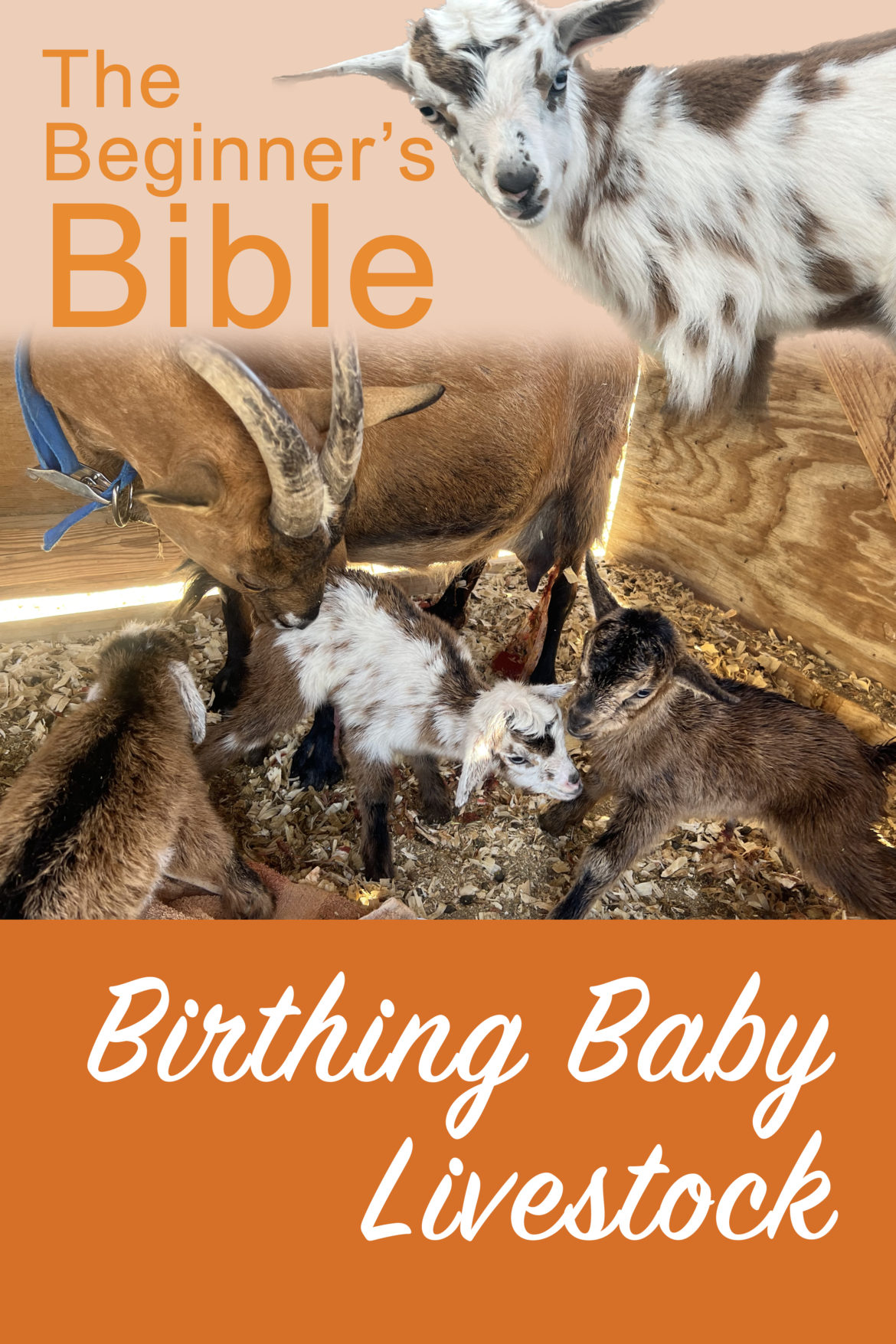The Beginner’s Guide to Labor and Delivery
Spring is here and babies are popping out everywhere! Most of the time mothers give birth without complications, but when things go wrong birthing livestock, time can be critical. No matter whether you are birthing horses, goats, cattle, sheep, dogs, cats, etc., here’s some tips and equipment that I always try to keep on hand!
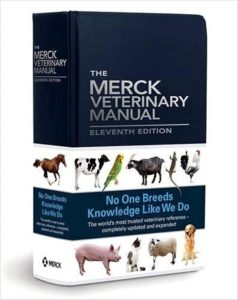
This post contains Affiliate links. Please see our Affiliate policy here.
This birthing livestock post is especially close to my heart right now as we prepare to have a litter of Aussie puppies later this week and all four of our milk goats are due to have kids in about a month! ‘Tis the season!
I am not a licensed veterinarian. I recommend always following your vet’s advice first and foremost. This post is intended for general information and what I do with my own animals. I’ve had the privilege of helping birth dozens of baby animals (maybe over a hundred at this point). Every livestock birth will be different than the last, but the basics are the same. Know when you need your vet’s help and definitely call them if you are in over your head!

I also recommend purchasing guidebooks on Amazon or borrowing books from your library (if they have them) on birthing livestock and do as much to educate yourself BEFORE your animals give birth! In fact, you should just go ahead and buy Keeping Livestock Healthy on Amazon before you get livestock. Knowledge is power!
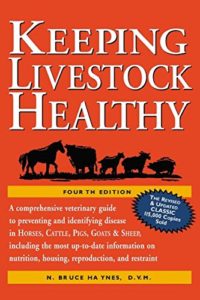
Prepping for Labor – Birthing Livestock
Animals need a healthy diet and vitamins throughout pregnancy just like moms everywhere! According to Mother Earth News, mother animals should be wormed, vaccinated (with appropriate vaccinations for pregnancy) at least 30 days before their due date.
Supplies
The last 30 days of gestation is a prime time to gather up your midwife supplies (for animals). Here’s a list of what I keep on hand:
- Have several clean drying towels handy (old bath towels are my go-to)
- A small bottle filled with iodine for newborn’s umbilical cord
- Sterile scissors for cutting the umbilical
- Suction bulbs
- Umbilical clamps
- Iodine
- Latex or Nitrile Gloves
- Oral Calcium (for or cats dogs in labor)
- Large bowl for hot, soapy water (in case you need to assist)
- Heat lamp (just in case)
- Cell phone with your vet’s emergency contact info
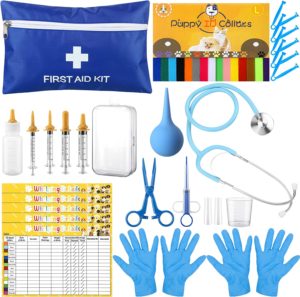
Labor Signs – Birthing Livestock
Mother animals begin to exhibit changes close to birth that can really tip you off that labor is imminent.
Mood Changes
Mother animals (and people) will exhibit changes in mood. Generally speaking, they start to look really miserable, especially when contractions have started. Mothers near labor may become more affectionate than they normally are when interacting with you.
Physical Changes
Always check for a discharge of any kind. Up to a week before labor, mothers will pass the mucus plug. With goats, I usually notice a discharge before I notice actual contractions beginning.
Their bag, teats, or udders will become tight. Horses will develop a waxy coating within the last couple days of gestation.
Mothers’ belly shape changes as the baby enters the birth canal. This is often called seeing the belly “drop.” With the baby’s head and front end pointed up, their bottom causes the belly to appear much lower. The mother’s hips will also start to look “hollowed out.” The area between the hip bone and tail begins to look concave and it’s especially noticeable in animals like horses and goats.
When labor has started and baby is moving through the birth canal, it causes frequent potty breaks.
Behavioral Changes
Mothers start looking restless and seeking solitude or sheltered place to deliver their babies. Prepare a separate livestock birthing pen or area for your mothers a week or so before her due date. I put in a fresh, clean layer of pine shavings in my goat sheds.
Animals near labor will sometimes demonstrate a lack of appetite or walk away in the middle of a meal. Other times they will eat like normal so keep an eye out for anything unusual.
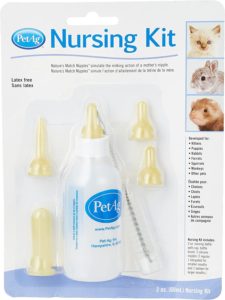
Goats like to push their head against a fence or building when they are having labor pains. Horses paw when they are in pain and look at their tummy. Dogs start to pant and dig (as in burrow for a den) when they have contractions. You will know when something is out of the ordinary with their behavior if you know your animal well.
Labor Has Started, Now What?
For a normal delivery with no complications, the usual progression of birth goes: the head and both front legs are in position together coming out, the mom does most of the work, you clear the baby’s nose and mouth of mucus and stimulate them. Mom will also help clean them and stimulate them. Finally, get them up and nursing ASAP. The mother will have colostrum for the first day or so after birthing. Baby’s need to get colostrum right away to get a head start on survival. A nursing baby also stimulates more contractions for the mom to pass afterbirth or the next baby if there are multiples.
Check on your laboring mom frequently! Labor can go on for a few hours or most of the day, depending on the mom-to-be. They don’t always appreciate hovering too much and they definitely pick up on any anxiety or stress you are putting off. Be calm and soothing. Watch their progression so you’re aware when they’re ready to start pushing.
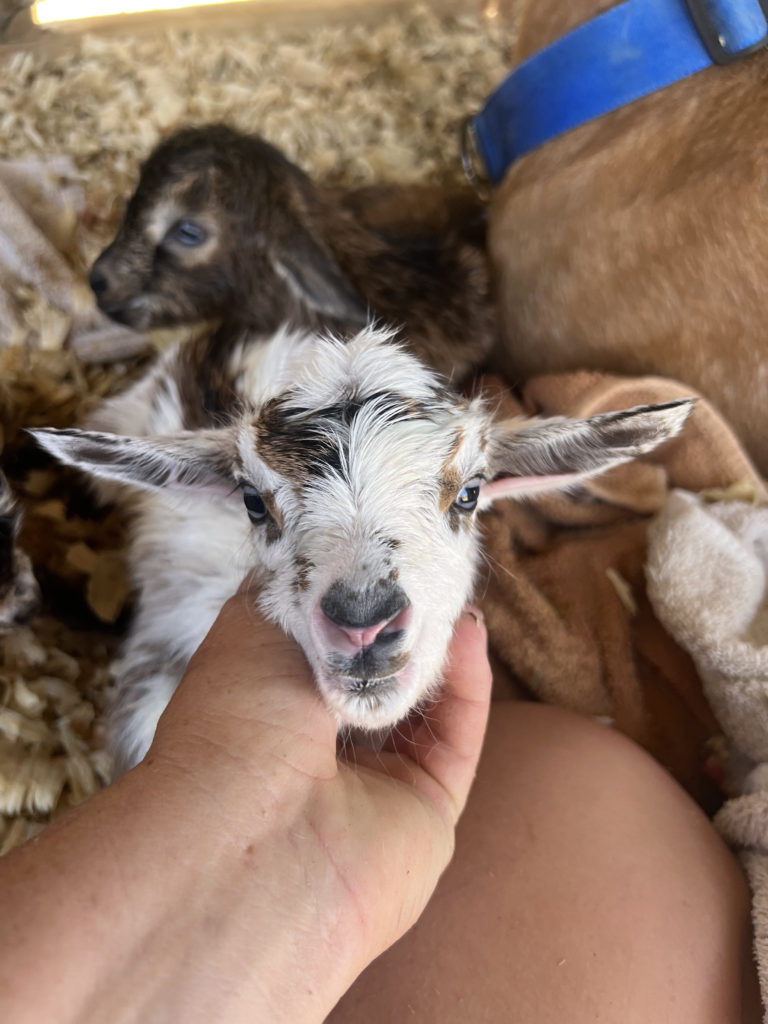
The Delivery
Check your watch when the mother gets down and really starts pushing. Pushing for more than an hour without progress is a sign that she may need your assistance. 2 hours of pushing with no baby is a HUGE red flag. With large animals like horses and goats, that means reaching in to get the baby’s legs and head into the right position and pulling gentle to help her push them out. Smaller animals are trickier, because you can’t physically reach in to help get the baby out. This usually involves the vet and a c-section may be needed.
Under normal circumstances, the baby’s head and front legs will start to appear together. Make sure both front legs are present. Delivery is easiest when the baby is doing a “swan dive” out of the mother. Sometimes one leg will get stuck in a downward position and you will have to reach in to get it up into position with the other one. Time is critical. If you notice something wrong, help is needed right away. The longer you wait, the worse the situation gets. If you’re new to birthing livestock, it helps to have an experienced mentor you can call or who’s able to come and help you in person!
After Birth Care
During a normal delivery, the baby will slide right out once the mother pushes the shoulders through. That’s when I use my clean towels and suction bulb to clean the face, nose and mouth. I always make sure the baby is breathing first and foremost. Next, I clamp the umbilical and cut it (you can dip it in iodine or another antiseptic to prevent infection). This step may not be necessary if the mother is already actively cleaning the baby and, as gross as it is (eating the afterbirth). They chew through the umbilical themselves if you don’t do it before they get there. I like to make sure the mom doesn’t pull too hard on the umbilical and cause a rupture.
Make a mental note if the mom has passed the afterbirth. It is important that it not be left inside them. If you do not see it come out of the mother right away and her contractions have stopped, this is time to talk to your vet about it. They can give a shot to stimulate more contractions and hopefully get it to pass.
Once the baby is breathing and the umbilical is cut, next I stimulate them with the clean towels, drying them briskly. Babies are usually already getting to their feet or moving around a lot by this time. I move them to their mother’s udder or bag and get them nursing immediately.
Good Luck!
Unfortunately, there will always be losses with livestock. This is something to keep in mind. Even with the best care, some babies are stillborn and others die during or after birth. Sometimes, the mother has complications. Sadly, this is part of life on the farm. Be prepared to face something like that, but I pray for the best outcome for your mother and her babies. Best of luck and enjoy your new little ones!
Enjoying this post? Check out my other blog posts here! Don’t forget to subscribe so you never miss out!
